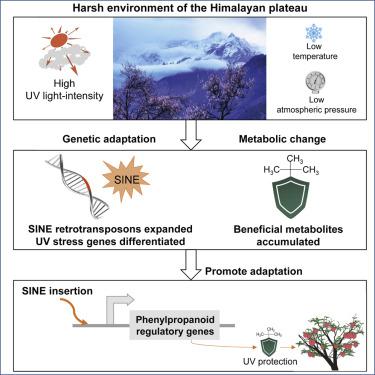Current Biology ( IF 8.1 ) Pub Date : 2021-07-26 , DOI: 10.1016/j.cub.2021.06.062 Xia Wang 1 , Shengjun Liu 1 , Hao Zuo 1 , Weikang Zheng 1 , Shanshan Zhang 2 , Yue Huang 1 , Gesang Pingcuo 2 , Hong Ying 2 , Fan Zhao 2 , Yuanrong Li 2 , Junwei Liu 1 , Ting-Shuang Yi 3 , Yanjun Zan 4 , Robert M Larkin 5 , Xiuxin Deng 6 , Xiuli Zeng 2 , Qiang Xu 6

|
The Great Himalayan Mountains and their foothills are believed to be the place of origin and development of many plant species. The genetic basis of adaptation to high plateaus is a fascinating topic that is poorly understood at the population level. We comprehensively collected and sequenced 377 accessions of Prunus germplasm along altitude gradients ranging from 2,067 to 4,492 m in the Himalayas. We de novo assembled three high-quality genomes of Tibetan Prunus species. A comparative analysis of Prunus genomes indicated a remarkable expansion of the SINE retrotransposons occurred in the genomes of Tibetan species. We observed genetic differentiation between Tibetan peaches from high and low altitudes and that genes associated with light stress signaling, especially UV stress signaling, were enriched in the differentiated regions. By profiling the metabolomes of Tibetan peach fruit, we determined 379 metabolites had significant genetic correlations with altitudes and that in particular phenylpropanoids were positively correlated with altitudes. We identified 62 Tibetan peach-specific SINEs that colocalized with metabolites differentially accumualted in Tibetan relative to cultivated peach. We demonstrated that two SINEs were inserted in a locus controlling the accumulation of 3-O-feruloyl quinic acid. SINE1 was specific to Tibetan peach. SINE2 was predominant in high altitudes and associated with the accumulation of 3-O-feruloyl quinic acid. These genomic and metabolic data for Prunus populations native to the Himalayan region indicate that the expansion of SINE retrotransposons helped Tibetan Prunus species adapt to the harsh environment of the Himalayan plateau by promoting the accumulation of beneficial metabolites.











































 京公网安备 11010802027423号
京公网安备 11010802027423号